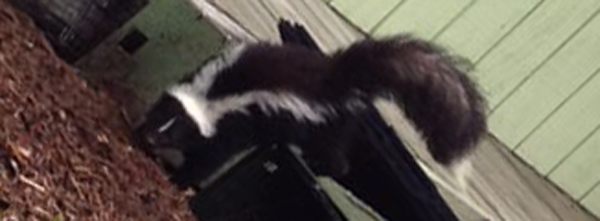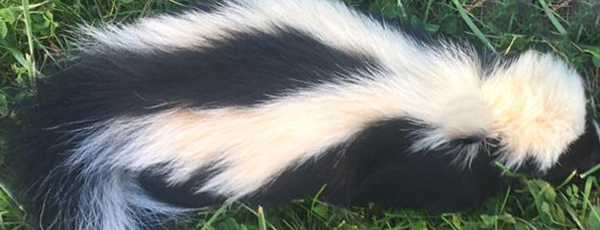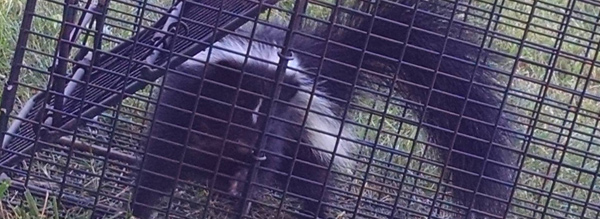- info@wildlife-removal.com
Call us for help in your town
Wildlife Removal Education
Why Skunks Spray
Need skunk removal in your hometown? We service over 500 USA locations! Click here to hire us in your town and check prices - updated for year 2020.
Skunks are a species that are common in many areas of the United States, and one of the first things that many species of animal will teach their cubs or young ones is not to get too close to the creatures with the bold white stripe down their back. The reason for this is that skunks have the ability to deter their potential predators in a very clever way, and this involves spraying threats with a particularly potent and foul smelling musk which can be very unpleasant. There are several reasons why skunks have developed this ability, but in truth it is a key part of why the species has managed to be so successful and has been able to thrive in many areas of the world.

Skunks Spraying As A Survival Mechanism
The primary reason that skunks have developed the ability to spray this foul smelling liquid is that it proves to be a very effective deterrent against those animals that might view the skunk as potential prey. One of the most important parts of this ability to spray is that skunks can actually be quite accurate over a short distance, and any animal that has the misfortune of being sprayed will find they have an ongoing stench that remains for a fairly long time, and will learn not to try and attack skunks again. As a deterrent, this is certainly one of the most successful evolutionary ways to deal with predators, and has certainly proved effective for the skunk.
How To Avoid Being Sprayed By A Skunk
If you do encounter a skunk when you are out walking or exploring the countryside, then the first thing to remember is that you should not try to get any closer. Because of the strong smell and slightly toxic nature of the spray, try to protect your eyes, and then back away from the animal slowly. Signs that the skunk may be about to spray can include snorting noises, and also the stamping and scraping of the ground with its paws in the way that some animals do when they are about to charge. The less of a threat to the animal that you can appear to be, the better your chances of not being sprayed by the skunk.
The Development Of The Spraying Instinct In Young Skunks
For those who have to deal with skunks around their property, if you trap a skunk in a cage trap you can throw a blanket over the trap to try and stop the animal from spraying. However, you may then have to deal with baby skunks, and babies will not quite have the same control over the spraying instinct as adults, and can spray even when they don’t feel threatened. So, if you are having to deal with baby skunks, make sure that you are wearing old gloves and long sleeved clothing that you are happy to dispose of (or at least wash several times afterwards!) when you are handling and removing these young skunks.
Why Is A Skunks Spray So Pungent?
The chemical within the skunk’s spray that actually causes the strong smell is a sulphur based compound known as a thiol, and the skunk will usually only have a small amount of this that is enough to spray five or six times at most in their anal scent glands. Most skunks will have a spray made of three or four different thiols, which are really the key to its pungent spray. Only ten parts per billion of these chemicals are needed in the atmosphere to be detected by the human nose, which is why it is so potent and such a difficult smell to get rid of once you have been sprayed.
Go back to the Skunk Removal page.
Can Skunks Run Out Of Spray?
The smell of a skunk's spray is said to be so strong that it can be smelled at over a mile away from where the spray was released, so it is no surprise that it is a strong deterrent that helps to keep the skunk safe. Indeed, many predators will avoid the skunk completely, and it will only take one attempt for other animals to decide that the skunk is too difficult to hunt, and will look for easier prey. However, why would a skunk show so many signs of its intent to spray if it actually carried a large amount of the fluid in its anal glands.

How Much Scent Does A Skunk Produce?
The skunk will usually only carry a small amount of the musky compound in their glands at any one time, and will often depend on the threat of spraying to deter predators, rather than the actual act of spraying. The spray itself is made up of three thiol compounds which only need to have a concentration of ten parts per billion to be smelled by the human nose, and around ten to fifteen milliliters of this is kept in the animal's anal glands.
The Number Of Times A Skunk Can Spray
The glands that hold the spray release a small amount of the fluid every time the skunk will spray, and the animal will largely depend on releasing a small amount accurately rather than releasing a lot of the spray. For this reason the fifteen milliliters found in the anal glands are actually spread over five to six sprays, and if the skunk has used all of this it will have to wait until its body can produce more of the fluid.
Alternatives To Spraying A Potential Threat
Because of the amount of fluid that a skunk will carry, it will try to give several signals to the potential threat that it intends to spray, to try and avoid having to actually use the fluid from the anal glands. These signs include making low growling and hissing noises, along with high shrieks, while fluffing up their fur and scratching or stamping the ground with their feet is another sign that they may be about to spray.
How Long Does A Skunk Take To Produce More Spray?
The skunk doesn't produce these compounds particularly quickly, and if a skunk has completely used up all of its store of the fluid, it can often take up to ten days for it to completely produce a full gland of the fluid.
Go back to the Skunk Removal page.
Will Skunks Warn Before They Spray?
Anyone who has had to deal with a child or a pet that has been sprayed by a skunk will know that it is not a pleasant experience, and particularly in the case of pets that have made it into your home before they are cleaned, the smell can stay around for quite some time. The difficulty is that the skunk will actually show a range of different warning signs before they spray a person or animal that they view as a potential threat. Because they do not encounter skunks regularly, children and domestic animals will however not realize that these signs are actually warning that they may be about to spray.

Signs Displayed By The Skunk
There are several physical signs that the skunk will display before they actually spray a potential threat. Some of these signs are vocal, and while some skunks will use a deep low growl, others can use hissing noises and yet other skunks may use a loud wail to try and deter potential threats from getting too close. Some skunks will also paw aggressively, stamp their feet or scratch the ground. The final sign is when the skunk lifts its tail, but at this point it will usually be too late for you to get out of the way.
The Reason Skunks Do Not Spray Immediately
Skunks have developed the glands that produce the foul smelling musk, but these glands are actually fairly small and do not carry an infinite supply of this fluid. For this reason they will try to use other warnings to deter predators or a potential threat before they commit to spraying their fluid, as they can only spray five or six times, and it can take up to ten days for the skunks to produce a new stock of this fluid.
What To Do If You Encounter A Skunk
The key thing to remember when you encounter a skunk is that it will not actually want to spray you, and generally it will not do so unless you alarm it to the point where the skunk feels it has no choice but to release its spray. You should try to avoid any quick movements, as this may cause alarm to the skunk, but rather back away slowly and deliberately, and try to ensure that the skunk has an adequate escape route that it can use to get away from you. If you do see it start to raise its tail, turn away and try to protect your eyes, as that is where it will try to aim its spray.
Go back to the Skunk Removal page.


















